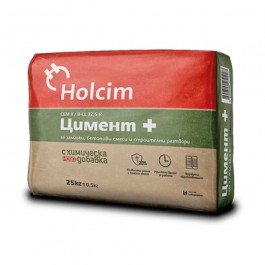Cement
For the first time, cement was created in the 19th century by the mason Joseph Aspdin from Leeds, England, who burned powdered limestone and clay in his kitchen stove. He initiated an industry.
Two centuries later, cement remains one of the most preferred construction components. It is very versatile and finds its application in numerous construction projects, both in domestic settings and professional construction.
Masons also like the material because it is quite economical and cost-effective for construction activities, while also being an environmentally friendly raw material.
How is Cement Made?
In modern times, cement is produced under laboratory conditions, and before it reaches the end-user, each bag of cement has gone through a series of rigorous studies and tests. Many manufacturers rely on the dry production method.
In this process, all elements - limestone, shells, chalk, or marl combined with shale, clay, silica sand, and iron ore are ground to obtain a dry, homogeneous mixture. After heating, these ingredients form a rock-like substance called clinker, which is then ground into fine powder - cement.
Different Types of Cement
Below, we have described the different types of cement and their applications to help you choose the right material for your construction goals.
- Asphalt concrete - primarily used in the production of pavement mixes. It consists of about 5% asphalt cement and 95% inert materials, mainly including sand and aggregate.
- Cement boards - consist of cement containing cellulose. These boards are usually used as underlayments and are preferred over paper-covered gypsum boards, especially in areas with high moisture levels.
- Fire-resistant - resistant to heat, used as a base for fireproofing compounds to seal joints in hot areas.
- Orthopedic bone cement - while this type is not related to construction, it is an essential material in orthopedic surgery.
- Fiber cement - a composite material that combines cheap cement with cellulose fibers. It is used in both residential and industrial construction, most commonly for building roofs.
- Green - created from calcined clay and powdered limestone. Its production process reduces carbon emissions, making it environmentally friendly and offering increased mechanical strength.
- Hydraulic - a combination of limestone, gypsum, and clay, burned at extremely high temperatures.
- White - a very strong type of cement that allows for creating interesting and captivating decorative structures.
Advantages of Cement as a Building Material
Cement has become an integral part of our daily life because it is the only building material that genuinely offers the following advantages:
- Ready-made cement is the material with the lowest carbon footprint when used in construction.
- Cement Holcim offers unmatched strength, durability, longevity, and resistance.
- It is available at an affordable price while ensuring maximum energy efficiency through its thermal mass.
- It retains its durability in any environment, regardless of how harsh the conditions are.
- This building material does not burn, is resistant to rust and decay.
- Thanks to its strength, cement bags help improve the safety and security of structures.
- Finished cement is appealing to builders for its flexibility, as it can be molded into any shape and color.
- Cement mixtures do not produce exhaust gases.
- It is an inexpensive material, yet it provides excellent sound insulation.
- Projects made with Cement Holcim require minimal maintenance costs.
- 100% recyclable, making it more environmentally friendly.
Usage
The material has universal application, which makes it cost-effective and high-quality construction material. Its consistency and tremendous versatility make it an ideal choice for almost all construction applications. Ready-made cement meets all quality standards for construction. You can use it in various areas, including:
- Plastering and masonry;
- Creating joints for pipes and channels;
- Providing waterproofing for the structures of construction objects;
- Cement bags are used in concrete mixes for flooring, roofing, and constructing partitions, beams, columns, and more;
- Finished cement is applied where a solid surface is needed to protect outdoor parts of structures against adverse atmospheric conditions, some organic or inorganic agents;
- Cement Holcim is also used in the production of assembled pipes, fence posts, pilings, and so on;
- Different types of cement enable the quality construction of important engineering structures like bridges, dams, tunnels, and others;
- With this material, you can create foundations, waterproof floors, pedestrian paths;
- Cement bags are affordable, so they are used to build wells, water tanks, tennis courts, lamps, etc.
In Atek 1 construction store, you will find a wide variety of cement at competitive prices, which will be the key component of the success of your construction project. Contact us now to order the cement bag you need.
